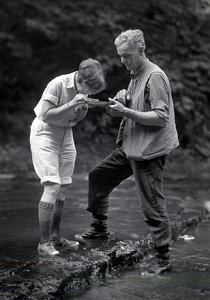
At a time when university-level co-education was still in its infancy, James Needham's classes included a strikingly large percentage of women. Image provided by James G. Needham papers, courtesy of Cornell University Library's Rare and Manuscript Collections.
A pioneer's legacy: Needham endowment helps boost Mann's limnology collections
More than 100 years ago, a Cornell professor took his passion for fieldwork and freshwater science and spun them into an entirely new field of study: limnology.

Needham and three students examine an aquatic organism in freshwater, most likely Cascadilla Creek or Fall Creek during the early 1930s. Image provided by James G. Needham papers, courtesy of Cornell University Library's Rare and Manuscript Collections.
Professor James G. Needham taught the first limnology course in the United States -- and possibly in the world -- at Cornell in spring 1908. He continued to teach the general limnology class until he retired in 1935, describing it in the course catalog as "an introduction to the study of the life of inland waters. Aquatic organisms in their qualitative, quantitative, seasonal and ecological relations."
The course kicked off a limnology program at Cornell that still flourishes today -- and a new gift from James G. Needham's estate is providing for its future.
Cornell University Library recently received a major bequest from Needham's grandson, James W. Needham, to support Mann Library's collections in entomology, limnology, ecology and natural history. The new gift boosted Needham's existing endowment, creating the single largest acquisitions endowment at Mann.
"This generous gift will provide some important new -- and very timely -- annual funds for acquiring materials that support scholarship in fields that were clearly near and dear to Professor Needham during his time at Cornell," says Mary Ochs, director of Mann Library. "It is a great honor for the library to be playing a part in commemorating and helping to continue this Cornell legacy."
James W. Needham died in March 2010. His family's fund is already contributing to the wealth of resources at Cornell, allowing the library to purchase current entomology journal subscriptions and historical journal issues. These acquisitions support taxonomic and field research, and more broadly, the fund will enrich the library's online resources for graduate students and faculty members in many disciplines.

Needham and a student examine a sample. At Needham's death, his student H.H. Schwardt wrote, "Any student who had the privilege of going into the field with him has a lasting memory of a great naturalist at work." Image provided by James G. Needham papers, courtesy of Cornell University Library's Rare and Manuscript Collections.
"We've had an amazing succession of people in this field. I put together a family tree of limnology here, and you can see this wonderful thicket of people growing from that initial seed he planted," said Nelson Hairston Jr., the Frank H.T. Rhodes Professor of Environmental Science. "People here are studying everything from the adaptation of individual organisms to how global climate change affects the study of lake ecosystems worldwide."
While conducting research for a celebration of the 100th anniversary of limnology at Cornell, Hairston and a team of librarians discovered an original letter from Charles Darwin amid Needham's papers in Cornell University Library's Division of Rare and Manuscript Collections. The undated letter to a correspondent subsequently identified as the young English biologist Henry Reeks is written in a barely readable scrawl and signed, "With my best thanks, pray believe me yours very faithfully & obliged Ch. Darwin." (Learn more about the Darwin letter in a 2010 CornellCast video).
Needham's materials in the library's archives also reveal that fieldwork was fundamental to Needham's teaching. The archives contain hundreds of photographs of students knee-deep in streams and ponds, holding nets, buckets and lenses, utterly engrossed in the life around them.
Together with Cornell entomologist John Henry Comstock, Needham helped build the country's first permanent field station for limnological research. Comstock persuaded Cornell trustee Jared T. Newman to donate five acres of land at the mouth of Fall Creek to the project and talked Liberty Hyde Bailey into supplying building material from the old dairy building at the Agriculture College.
Needham was also a pioneer in another way: At a time when university-level co-education was still in its infancy, Needham's classes included a strikingly large percentage of women. He supported them as vigorously as he did his male students, guiding them through graduate work and advocating for them in a hostile scientific community, although many of these women met with disappointment when they graduated and tried to enter the field.
"James Needham was a really interesting guy and clearly an inspirational teacher," Hairston says, adding that he references Needham's 1916 textbook in his own classes to explain the history of the field. "It's good to know where your roots are."
To celebrate Needham's life and contributions to his field and to the library, a new Mann Library exhibit -- "Inland Waters: James G. Needham and the Origins of Cornell Limnology" -- is now available online.